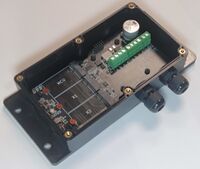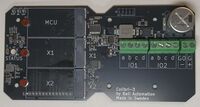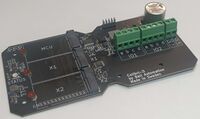Difference between revisions of "Colibri-3"
| (One intermediate revision by the same user not shown) | |||
| Line 3: | Line 3: | ||
[[File:Colibri-3-2.jpg|200px|thumb]] | [[File:Colibri-3-2.jpg|200px|thumb]] | ||
| − | Colibri-3 is a 3 slot carrier board, meant for [[Colibri MCU1]], but is equally suited for other MCU boards, like [[Colibri MCU2]] and [[Colibri MCU3]] that are intended for [https://esphome.io ESPhome] applications. | + | [[Colibri]]-3 is a 3 slot carrier board, meant for [[Colibri MCU1]], but is equally suited for other MCU boards, like [[Colibri MCU2]] and [[Colibri MCU3]] that are intended for [https://esphome.io ESPhome] applications. |
== I2C Addresses == | == I2C Addresses == | ||
| Line 9: | Line 9: | ||
== MCU Slot == | == MCU Slot == | ||
| − | The MCU slot is made for | + | The MCU slot is made for any Colibri MCU variant. |
It can be programmed from the pin header on the Colibri-3 | It can be programmed from the pin header on the Colibri-3 | ||
Latest revision as of 11:28, 20 July 2023
Colibri-3 is a 3 slot carrier board, meant for Colibri MCU1, but is equally suited for other MCU boards, like Colibri MCU2 and Colibri MCU3 that are intended for ESPhome applications.
I2C Addresses
TCA9548 = 0x70 ; Selects which I/O slot the I2C should be connected to.
MCU Slot
The MCU slot is made for any Colibri MCU variant.
It can be programmed from the pin header on the Colibri-3
Expansion Slots
Each expansion slot can be communicated to with I2C or SPI.
The I2C is connected via an I2C MUX on the board, to avoid address conflicts.
The SPI has a 3 Chip Select demux (PA0, PA1, PA2) signals per slot, only allowing selection of 1 CS at a time.
Each slot has +3.3V, +5V and +12V power, and the 3.3 and 5 Volt can be individually controlled on/off from the MCU. The external power supply is also available for the expansion boards to utilize.
Finally, each slot has 4 pins going to the 4-pole screw terminals on the Colibri-3.
Power Supply
The Colibri-3 can be powered by AC (5-36V) or DC (7-55V). But some expansion (Colibri Triac-1 for now) boards require AC power, and if powered with DC, those boards will not work.
The device consumes very little power, typically well below 1 Watt. Expansion boards may consume maximum 200mA on each power rail, and that may increase the power consumption substantially. The on-board power supply can supply 3A on 5V and 1A on 3.3V.


